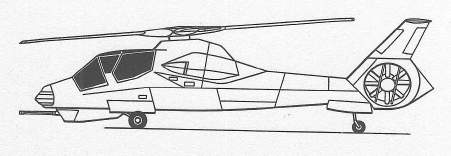PC Pilot
The Complete Guide to Computer Aviation
by Steve Smith
CHAPTER TWELVE
VERTICAL FLIGHT
Helos and Harriers
Man does not fly only as the crow flies—there are also hummingbirds to emulate. Helicopter sims bear a superficial resemblance to fixed-wing flight sims (the screen is split between scenery and cockpit views, for example), but as any real-world stick-and-rudder pilot can tell you, helos (only Hollywood calls them "choppers") are a whole other species.
In place of the familiar joystick, helos are flown by two altogether different controls: the collective, which adjusts the pitch (or "bite") of the rotor blades (more pitch equals more torque reaction, see below), and the cyclic, which looks like a joystick, except it works differently—you push on it to move forward (nose down), not to dive; and pull back on it to slow down or move back (nose up), not to climb.
With fixed-wing aircraft, an engine (jet or prop) pulls (or pushes) the plane forward, and the resulting airflow over the wings creates lift. Aloft, "steering" is controlled by horizontal and vertical flaps (elevators and rudder). In real life, the fixed-wing pilot has to coordinate the two—the joystick (or yoke) moves the elevators and foot pedals move the rudder. In most flight sims, the computer does the coordinating for you.
[Next slide, please.]
With a helo, the propeller is the wing; spinning it creates lift. To steer, you point the propeller in the direction you want to go. Sounds easier, doesn't it? In reality, it's much harder, particularly if there's only one main "rotor" (propeller). Every adjustment you make to the pitch makes the helo want to spin around the rotor axis. To counter this torque reaction, there's a secondary propeller, aimed sideways, in the tail. When you change the pitch (or the throttle), you have to apply an equal counterforce with the tail "fan," unless, of course, you want to turn while climbing or diving, in which case you have to split the difference.
After a while this becomes as much second-nature as double-clutching while downshifting in a race car, but at first—watch out! My friend Reeves tethered his half-million-dollar helo to the ground so it couldn't get more than a few feet airborne or tilt more than a few degrees while he was learning. He still managed to bend the skids on more than one occasion.
Since flying a helicopter is hardly intuitive—much less anything like flying a fixed-wing aircraft—most rotary-wing sims gloss over the frustrations of a realistic learning curve and make flight control as painless as possible. But in oversimplifying the process, they've reduced the experience to the complexity…or lack of it…of a Nintendo game.
Thus far, the only helo sim that comes close to approximating rotary-wing flight is MicroProse's Gunship 2000 (see below).
But there's one more problem.
Not only are helos vastly different from fixed-wing aircraft for the pilot, but helo sims also present an entirely different challenge for the programmer. With most flight sims, the detail and resolution of the scenery below is relatively unimportant, because fixed-wing aircraft spend most of their time not hundreds but thousands of feet up in the air. ("They are ants," as the old joke would have it, "we haven't taken off yet.")
Helos, especially in combat, spend most of their time as close to the ground as they dare, often flying nap-of-the-earth flight profiles and using terrain features to mask their presence from the enemy. And, since their top speed is only about a quarter that of a jet fighter's, the pilot can clearly see every tank track, every foxhole, every spent artillery round, and every tent stake, as if in bas-relief.
Until recently, armchair helicopter pilots had to be content with the same unconvincing "scenery" available in fixed-wing sims: billiard table stretches of featureless plains, triangular mountains, masking tape roads, rigidly geometric rivers, monochromatic skies, dogleg elevation changes, and Holstein-patterned clouds.
Then, in 1992, a previously unfamous company called Nova Logic introduced a scenery-modeling technique they called "Voxel Space" (trademarked, to be sure), which will forever change the way we look at scenery outside the cockpit.



Boeing-Sikorsky RAH-66 Comanche
Table of Contents | Previous Section | Next Section
